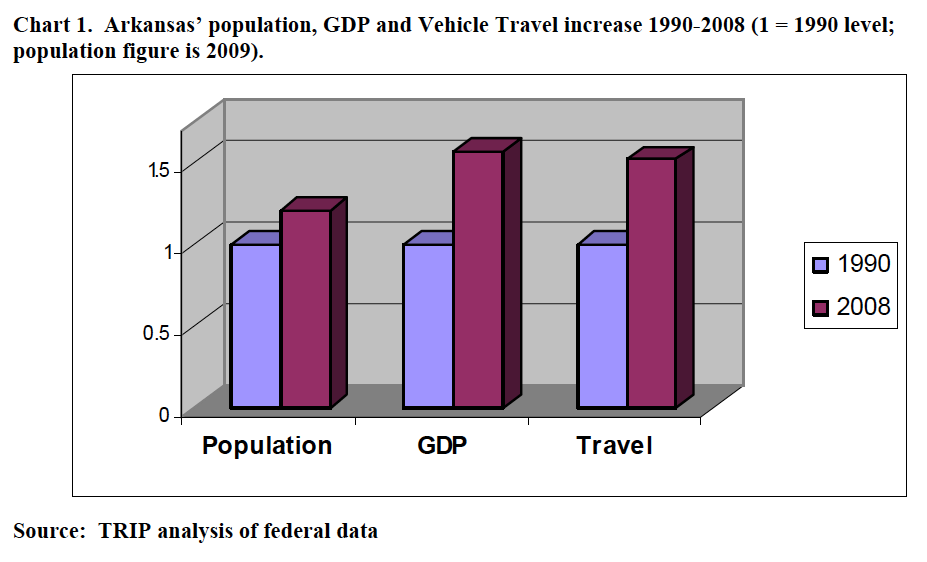THE ROAD INFORMATION PROGRAM (TRIP)
Executive Summary
Arkansas’ extensive system of roads, highways, bridges and public transit provides the state’s residents, visitors and businesses with a high level of mobility. As the backbone that supports the Natural State’s economy, Arkansas’ surface transportation system provides for travel to work and school, visits with family and friends, and trips to tourist and recreation attractions while simultaneously providing businesses with reliable access for customers, suppliers and employees. With an unemployment rate of 7.8 percent, and with the state’s population continuing to grow, Arkansas must improve its transportation system to foster economic growth, keep business in the state, and ensure the safe, reliable mobility needed to maintain and improve the quality of life for all residents.
As Arkansas looks to rebound from the current economic downturn, the state will need to improve the physical condition of its surface transportation network and enhance the system’s ability to provide efficient and reliable mobility for residents, visitors and businesses. Making needed improvements to Arkansas’ roads, highways, bridges and transit could provide a significant boost to the state’s economy by creating jobs and stimulating long-term economic growth as a result of improved mobility and access.
The federal government is an essential source of funding for the ongoing modernization of Arkansas’ roads, highways, bridges and transit. But recent declines in federal transportation revenues and increases in the cost of construction materials are making it more difficult for the state to maintain and improve its surface transportation system.
Approved in February 2009, the American Recovery and Reinvestment Act provides approximately $352 million in stimulus funding for highway and bridge improvements and $28 million for public transit improvements in Arkansas. This funding can serve as a down payment on needed road, highway, bridge and transit improvements, but it is not sufficient to allow the state to proceed with numerous projects needed to modernize its surface transportation system. Meeting Arkansas’ need to improve and maintain its system of roads, highways, bridges and transit will require a significant, long-term boost in transportation funding at the federal, state or local levels.
Congress is currently deliberating over a long-range federal surface transportation program. The current program, the Safe, Accountable, Flexible, and Efficient Transportation Equity Act – A Legacy for Users (SAFETEA-LU), originally scheduled to expire on September 30, 2009, now expires on December 31, 2010 following five short-term extensions. The level of funding and the provisions of a future federal surface transportation program will have a significant impact on future highway and bridge conditions and safety as well as the level of transit service in Arkansas, which, in turn, will affect the state’s ability to improve its residents’ quality of life and enhance economic development opportunities.
The federal surface transportation program is an essential source of funding for the construction, maintenance and improvement of Arkansas’ system of roads, highways, bridges and public transit.
- Federal spending levels for highways and public transit are based on the current federal surface transportation program, the Safe, Accountable, Flexible, and Efficient Transportation Equity Act – A Legacy for Users (SAFETEA-LU), which was approved by Congress in 2005. SAFETEA-LU, originally scheduled to expire on September 30, 2009, now expires on December 31, 2010 after five short-term extensions.
- From 1998 to 2008, Arkansas received approximately $5.04 billion in federal funding for road, highway and bridge improvements, and $239 million for public transit, a total of approximately $5.28 billion.
- On average, under SAFETEA-LU, federal funds provide 56 percent of revenues used annually by the Arkansas State Highway and Transportation Department (AHTD) to pay for road, highway and bridge construction, repairs and maintenance.
- Federal funds also provide 42 percent of the revenue used annually to pay for the operation of and capital improvements to the state’s public transit systems, which includes the purchase and repair of vehicles and the construction of transit facilities.
- From 1991 to 2008, Arkansas modernized approximately 7,500 miles and widened approximately 1,200 miles of major roadways and built, replaced or significantly reconstructed 1,508 bridges. These transportation projects improved safety and enhanced mobility and economic productivity. Many of the projects were undertaken with federal funds.
- This report contains lists of projects completed throughout Arkansas that used significant federal funding including rehabilitating 91 miles of I-30 from Texarkana to Little Rock and 132 miles of I-40 from the Oklahoma state line to just west of the Faulkner/Pulsaki County line and reconstructing interchanges on I-30 in Texarkana and on Hwy 63 in Crittenden, Pointsett and Craighead counties. Federal funding also helped Arkansas construct I-540, Hwy 549 and U.S. 67 to Interstate standards, widen several freeways, and reconstruct the existing roadway and add lanes on I-30 and I-40.
- While construction materials costs have stabilized somewhat during the current recession, a 58 percent materials cost increase in Arkansas over the past five years, coupled with declines in federal transportation revenues, will make it more difficult for Congress to authorize new federal surface transportation legislation that adequately funds needed improvements to the nation’s roads, highways, bridges and public transit systems.
Download executive summary (PDF): Future Mobility in Arkansas
Download full version (PDF): Future Mobility in Arkansas
About The Road Information Program (TRIP)
www.tripnet.org
“Founded in 1971, TRIP is a nonprofit organization that promotes transportation policies that relieve traffic congestion, improve road and bridge conditions, improve air quality, make highway travel safer and enhance economic productivity.”
Tags: AR, Arkansas, SAFETEA-LU







 RSS Feed
RSS Feed